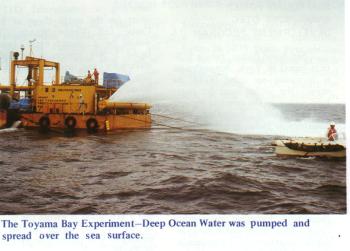With the support of the National Agency for Sciences and Technology (STA), the Japanese. Fishery Agency and the Japan Marine Science and Technology Center (JMSTC)have set up two laboratories dedicated to biotechnological experiments for deep ocean water applications (DOWA). Mr. Michel Gauthier of the IFREMER, Drs. Paul Yuen and C. Liu of the University of Hawaii and Mr. T. Daniel of the NELH were recently invited to visit these facilities. Shortly after the visit, they prepared a report and Mr.Michel Gauthier presented this report in the second IOA Planning Meeting. Highlights of their report are summarized as below:
| The Toyama Bay Artificial Up-welling Experiment | |
| The experiment was conducted a barge anchored on the sea bed at 300 m off-shore in |

¡@
Table 1. R/D projects conducted in the Cap Muroto DOW Testing Facilities.
|
TITLE |
RESEARCH ORGANIZATION |
RESULTS/STATUS(March,1990) |
| Basic studies on effective mass culture of useful diatoms by use of deep seawater | Japan Marine Science and Technology Center | Growth response of marine diatom to deep seawater is investigated and stimulative growth factors are identified |
| Researches on breeding of deep-sea fish Japanese Butter-fish | Deep Sea Water Laboratory, Kochi Prefecture | Successfully conducting the breeding of Japanese Butter-fish using cold deep seawater |
| Making of seaweed beds by using deep sea-water | Deep Sea Water Laboratory, Kochi Prefecture | Successfully conducting the culture of three species of seaweed |
| Chemical Speciation of bioessen tia1 trace metals in artificial up-welling water | Meteological Research Institute | Chemical form (organic and inorganic)and concentration of iron and copper are determined |
| Effect of deep seawater on nutritional quality of diet plankton | Nansei National Fisheries Research Institute |
Nutritional quality of marine Chlorella and rotifer that are cultured in cold deep seawater in investigated |
| Production of useful substances from deep seawater by micro algae | Government Industrial Institute, Chugoku |
Fatty acids and pigments contained in a green-algae, Dunaliella cultured in deep seawater is investigated |
| Cultivation of food phytoplankton with deep seawater using growth-simulating bacteria | Faculty of Agriculture, Kochi University |
Phytoplankton growth promoting bacteria is investigated |
| Disease and Immunization of fish cultured in deep seawater | Faculty of Agriculture, Kochi University | Development of the immune response of fish to prevent the expected diseases is examined in controlled temperature using deep seawater |
| Property of deep seawater supply system | Japan Marine Science and Technology Center |
A long term variation of temperature, concentration of nutrients and water intake rate on supplied deep seawater are investigated |
| Basic studies on effective mass culture of useful phytoplankton by use of deep seawater | Japan Marine Science and Technology Center |
Beginning |
| Research on breeding of abalone | Deep Sea Water Laboratory, Kochi Prefecture | Effect of cold deep seawater on survival rate of abalone is investigated |
| Feasibility study of microalga1 mass culture using deep seawater | Chlorella Industry Co., Ltd. | Beginning |
| Cultivation of marine animal broodstock and its development to breeding | Central Research Laboratory, Nippon Suisan Kaisha, Ltd. | Successfully conducting the breeding of At1anic sa1mom and flounder |
| Development of a water-tem-perature-control system for fish farming | Institute of Technology , Shimizu Corporation |
Successfully operating the system using heat exchanger and heat pumps |
| A distilling system of deep sea-water combined heat pump and fresh water generator | Nippon Yusen Kabushiki Kaisha, Ltd. |
Successfully operating the system |
The Bay of Toyama.
The deep ocean water required for the experiment was pumped from -250 m and spread over the sea surface.

The dimensions of the barge were 25m¡Ñ11m¡Ñ1.3m and its displacement was 320 tons. The flow rate of deep ocean water was 1 cubic meter per second. This experiment (Fig. 1) was performed for several weeks during the summers of 1989 and 1990. An oceanographic research vessel from the Fishery Agency was arranged and stayed in the test zone to monitor the physical, chemical, and biological properties of the sampled sea water to observe any significant changes due to the addition of enriched deep ocean water to the surface sea layer. The data obtained showed that the changes in biological environment was not significant because: 1)the amount of deep ocean water too small; 2)the dilution effect was rather significant; and 3)the temperature/density difference with surface warm water could only induce small perturbation of the surface layers ecosystem. Currently, a small OTEC heat exchangers experiment is being conducted on the barge.
| The Cap Muroto DOW Testing Facilities |
To enhance the DOWA development, a land based testing facilities is maintained in the Cap Muroto where the deep ocean water is pumped at depth-320 m through a 125 mm diameter iron shielded polyethylene pipe. The total length of the pipe is 2650 m and 300 cubic meter of water at temperature of 12¢J(intake temperature of 10¢J)may be supplied each day. The facilities are currently used to support related biotechnology and aquaculture research projects (Table 1.) Gauthier's report also mentioned that Kochi prefecture's Governor Hon. Tsutomu Nakauchi had indicated to him regarding their desire to coordinate a worldwide cooperative effort for DOWA development.
